We were given another clash between Manchester City and Newcastle United within 14 days, this one in a Premier League fixture that was played at the Etihad Stadium. Without any doubt, Pep Guardiola looked for a win, sent a very strong squad and put five past the opponent.
In this tactical analysis, we are looking at the tactics of Steve Bruce and Guardiola, particularly focusing on the transitions and reviewing some key positional plays.
Lineups
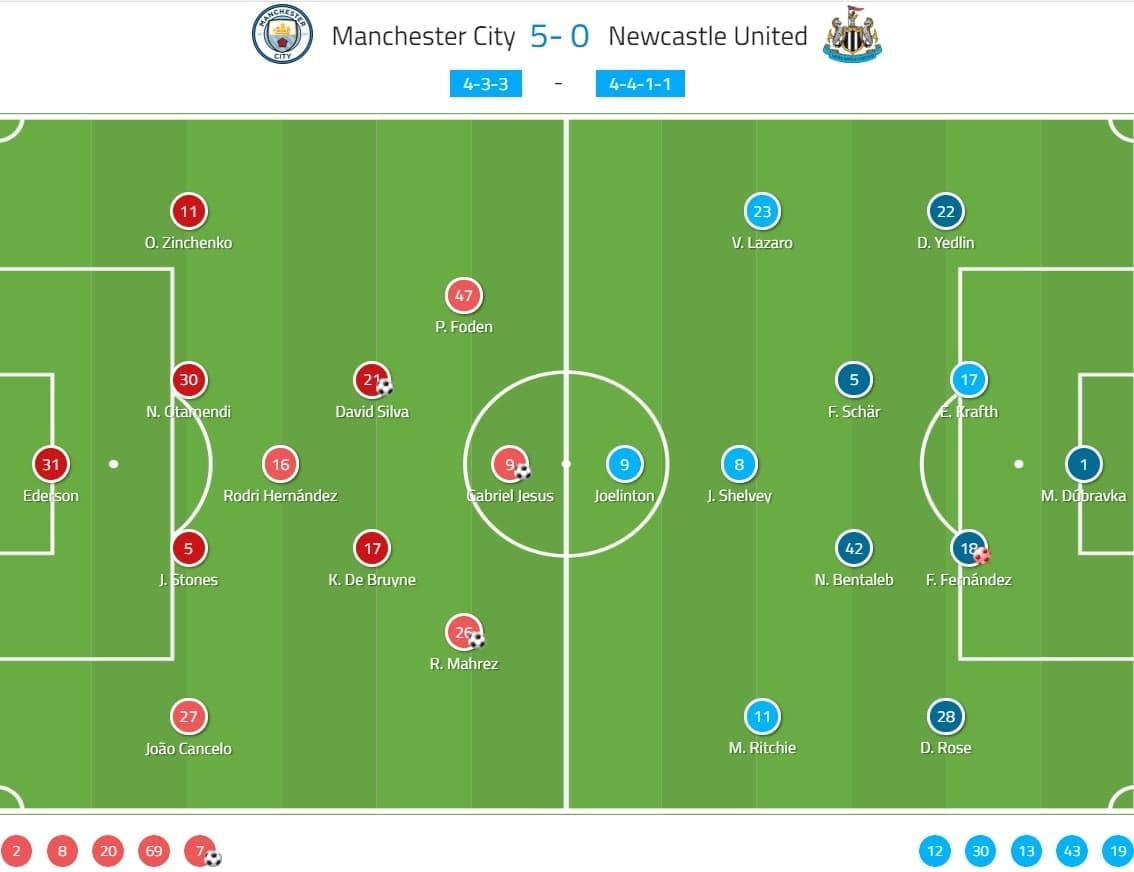
As usual, Manchester City played in a 4-3-3 formation with Phil Foden on the left-winger position. Finally, John Stones could play, and he partnered Nicolás Otamendi at the centre of the defence. Rodrigo Hernández operated as the sole pivot as Fernandinho and İlkay Gündoğan were on the bench.
Maybe the 4-4-1-1 of Bruce was a little surprise. Without the key attacking players such as Miguel Almirón and Allan Saint-Maximin, Matt Ritchie and Valentino Lazaro took the wide positions. Joelinton was the striker and was supported by Jonjo Shelvey.
The aggressive Magpies
The surprise from Bruce was not only the formation on paper but also their defensive approach. When reviewing the playing style of the team, we were expecting to see Newcastle set a deep block and commit players to defend while also looking for counter-attacking opportunities. This was the setup in the previous clash at least.
However, Newcastle were more aggressive than we expected. The block was set closer to City’s first line with a higher intensity of pressure. In general, the shape was a 4-4-2 or a 4-4-1-1 depending on Shelvey’s position. Partially this was a man-marking system as playing with this shape could mirror and match City’s wide players and the advanced midfielders.
As a reference, we drew the shape below. The man-marking was not strictly implemented because of City’s positional interchanges. Sometimes the defenders shifted the targets, but Magpies were more willing to step out early. Below, DeAndre Yedlin and Lazaro were close to the targets while the marking on David Silva was tight too.
Ideally, the tight markings reduce the time allowed on the ball receivers, forcing City to play quicker and potentially lower the quality. However, they focused too much on the players and the opponents were still the better side.
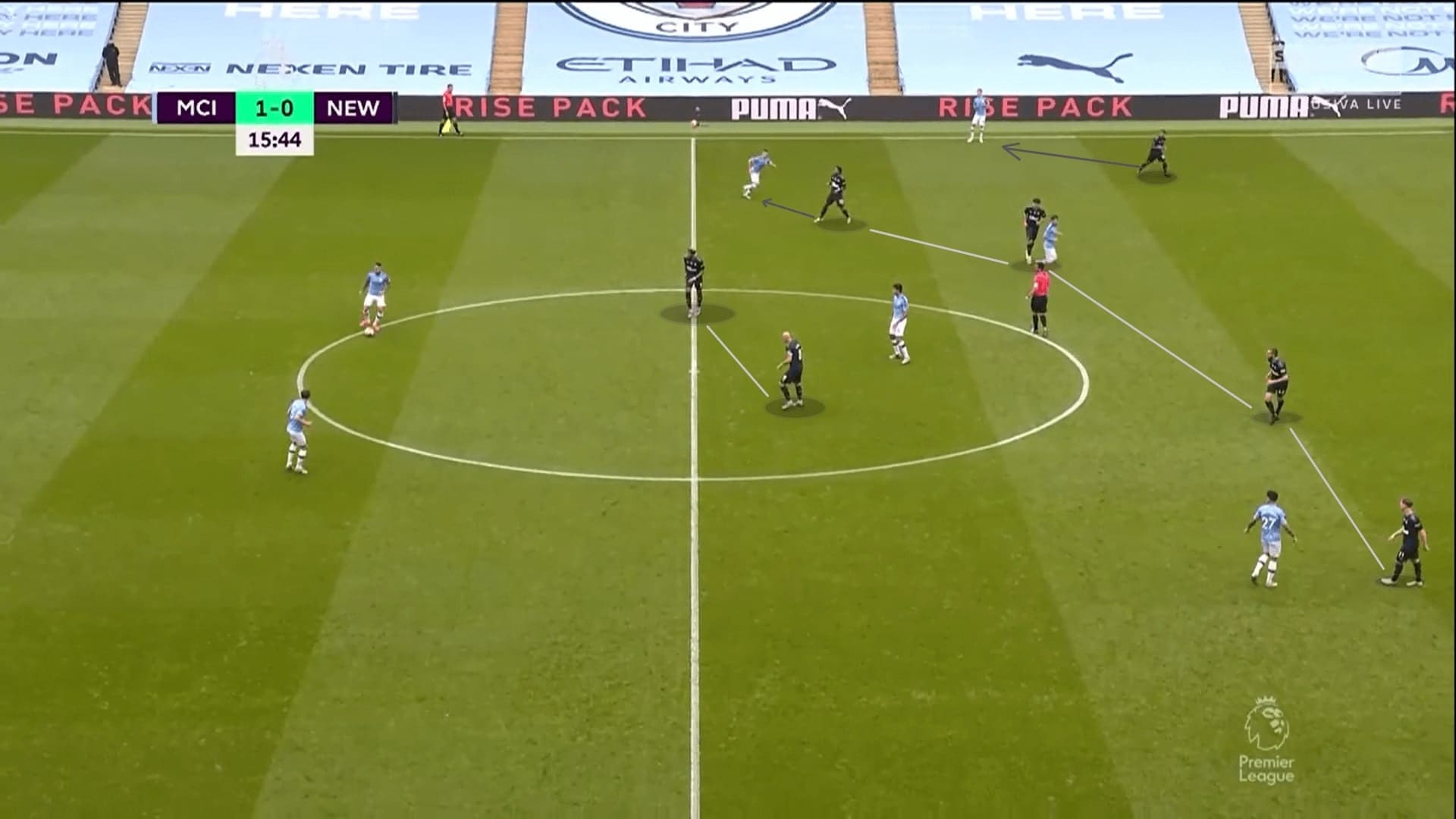
As mentioned, Newcastle were even pressing in the central third. Although the combination of Joelinton and Shelvey was an underload against the centre-backs and Rodri, this was not the main issue as shadowing the pivot was the top priority, as shown above.
Usually, the dropping player of City attracted and invited the ball-side winger to press. Although this was still an underload, the objective was to force some quicker plays and preventing the opponents from dictating the tempo and rhythm. Here, Ritchie (#11) moved to the first line as a response to De Bruyne’s position.
But City were just too good, the standard was incredibly high and sloppy mistakes were rare. Also, the quality of players was fascinating. In this example, De Bruyne was under pressure and being forced to his weaker foot, but De Bruyne is De Bruyne, the Belgian Star was exceptional. Average players would play the pass to Otamendi – the free player and it would not be a bad decision. De Bruyne, a world-class midfielder, used his weaker left foot to find Oleksandr Zinchenko on the opposite flank – a free player at a higher position. This helped the diagonal pass bypass the first and second lines and it was a pinpoint one, so Newcastle could not defend it.
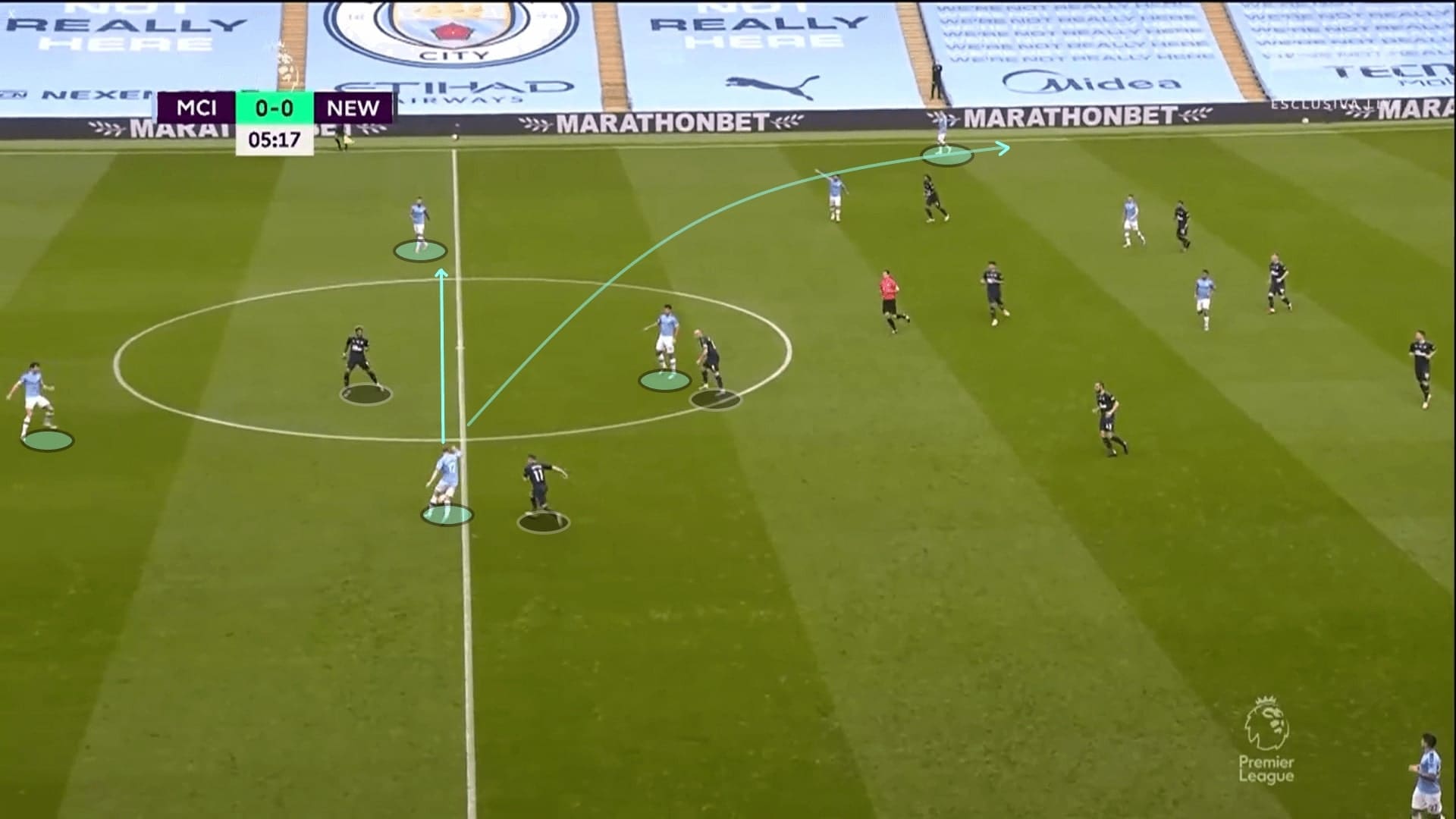
The man-marking scheme did not stop the progression of City, and we’ll explain the strategies of Pep’s troops later. Therefore, Newcastle were forced to set a deeper block when City progressed.
On some occasions, the block reverted to a 5-4-1, the usual shape of Newcastle, because of the man-to-man approach. In the hopes of containing Zinchenko in the attack, Lazaro tracked him and even dropped to become a part of the last line. The shape is shown below.
This was a disadvantage of the man-marking approach. The defending team was often reacting to the opponents’ movements instead of anticipating. Therefore, the Magpies were still passive and the approach had little effect on disrupting the attack.
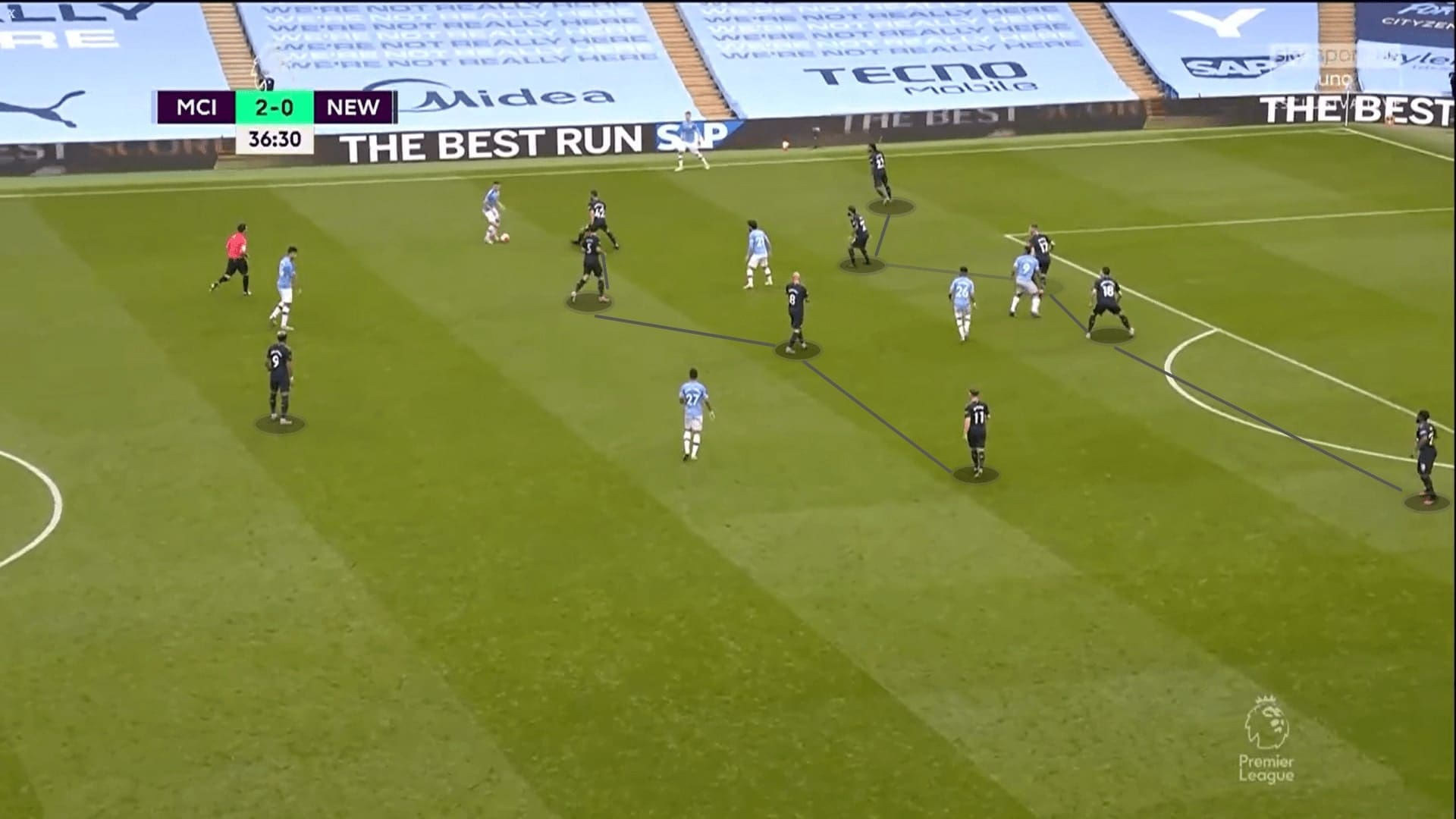
Manipulation of the second line
In some previous analysis, we explained the attacks of City, including the wide movements and generating options. However, this match was not about the above elements, and the key to progress was the manipulation of the second line.
As expected, Rodri was unavailable as an option because of the marking. But City did well by adding an additional player in the first phase, who was either an inverted full-back or a dropping midfielder. This was often the free player to receive a pass and progress plays.
D. Silva was phenomenal, the timing of his dropping movements was exceptional. Here, the Spanish midfielder appeared at the right time, came from the marker’s blindside, and provided himself as an option for Otamendi.
It was a vital move as the passing lane to Rodri was shut by Shelvey initially, while passing to Zinchenko was suboptimal because of the pressure around. Passing to D. Silva, a third man play was carried out easily and Rodri was available now, because of this comfortable one-touch pass.
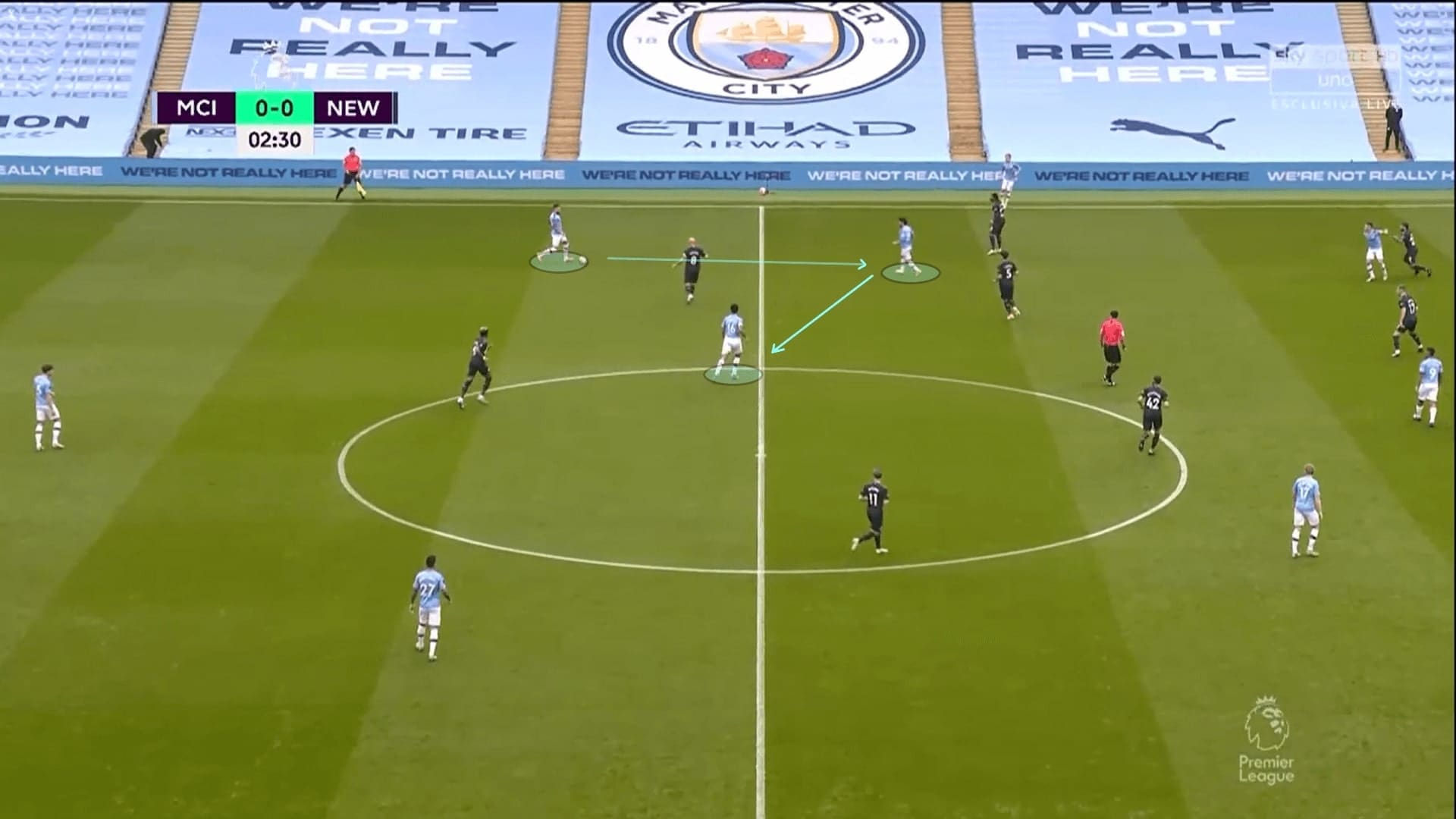
The positionings of D. Silva troubled the Magpies midfielders a lot. When dropping in front of the line, the perfect timing always kept the markers away. If the former Valencia player operated at the second line, this line was controllable because of the man-marking.
Here, De Bruyne possessed the positional superiority to receive the pass within the first line. He had spaces to turn thanks to D. Silva’s positionings, who stayed at the second line and kept Fabian Schär away from the first line. This offered spaces for the Belgian international to execute his next move, such as passing to a progressive option in the offensive third.
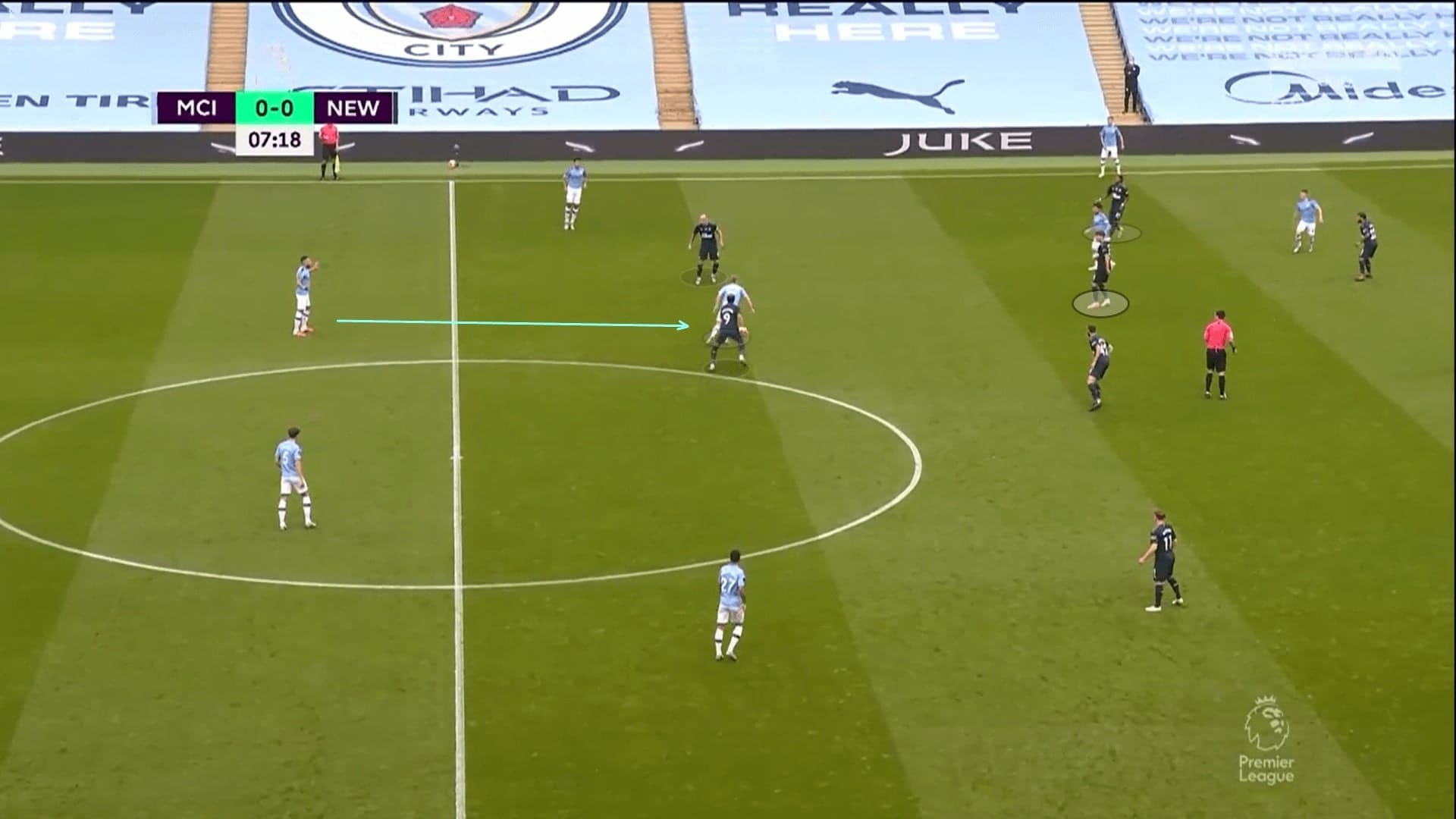
Another main method City used to progress was carrying the ball forward, but we have to stress again – all of these were attributed to the manipulation of the second line. By placing the midfielders behind the second line, the oppositions had scruples on stepping out, it was a decisional crisis.
In this example, D. Silva and De Bruyne were behind the second line, keeping Newcastle’s second line away from the first line. Spaces were opened for João Cancelo to dribble inward and escaped from Ritchie’s pressure. This allowed City to progress through the right-back and resulted in the opener of Jesus.
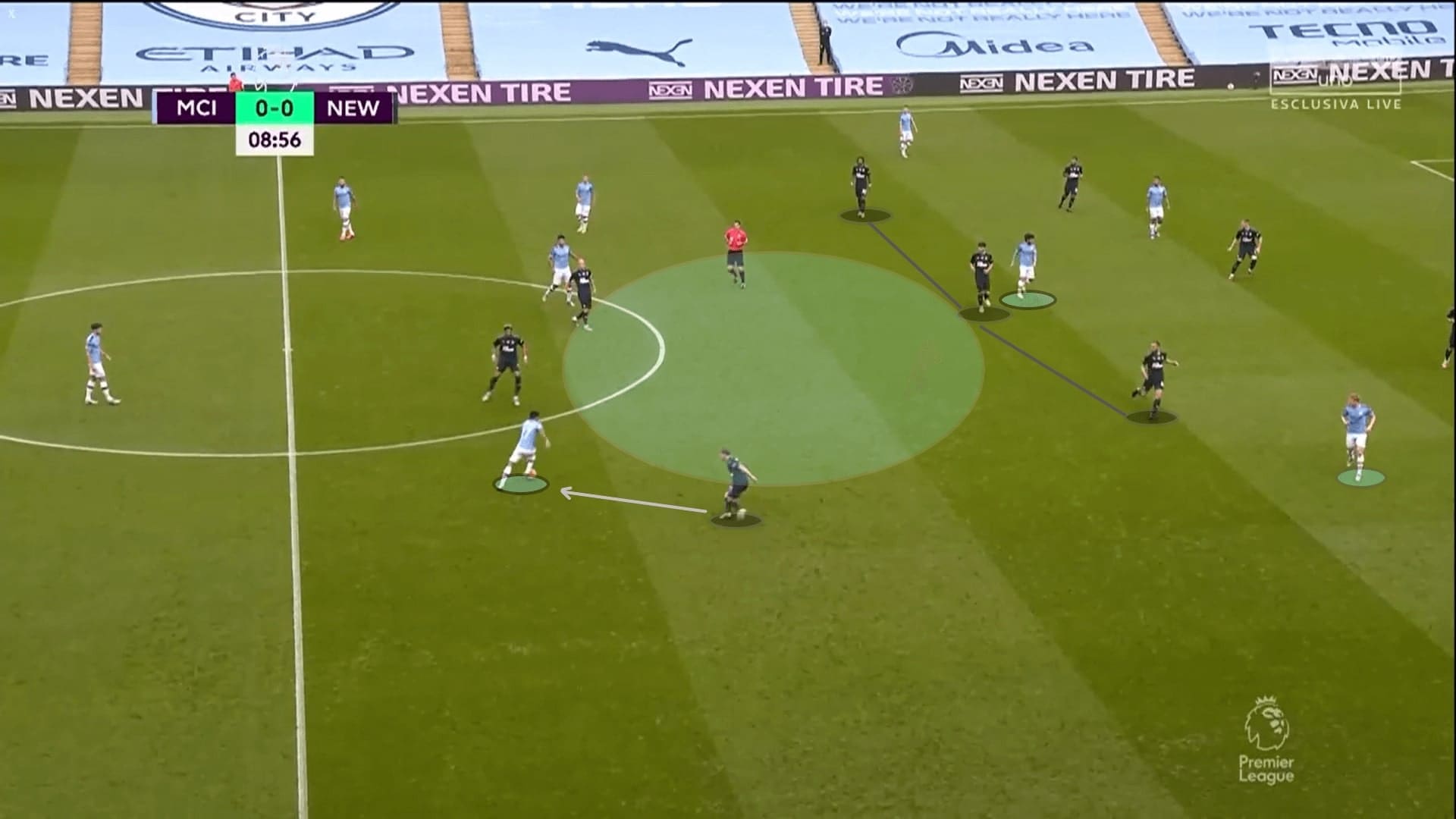
Utilising the superiorities
Apart from the excellent behaviours to manipulate the second line, City were also applying the concepts of positional play brilliantly. We noticed several types of superiorities were the effective tools that helped Pep’s men break the defence in the offensive third.
The first was the dynamic superiority. With a clockwise rotation on the left flank, City were unpredictable in attack and this confused the markers. When D. Silva dropped, Foden moved inward as a replacement for the Spaniard and Zinchenko would fill the outer zone. This was how the rotation has worked, which provided another set of dynamics for City to attack the left.
Although facing a man-marking approach, Foden, D. Silva and Zinchenko were not marked because of the positional interchanges. It was impossible for Yedlin to track Foden and get into the central area, the job was left to the midfielders. But, manipulation of the second line was still observable even when D. Silva was not here. Look at De Bruyne, who stretched the midfield, attracted a player and opened spaces at the centre.
Again, a third man combination was used, and this was a wise move by Cancelo. Directly finding Foden was fine, but the Magpies could track the youngster too. Passing to Jesus first was optimal as the Brazilian could draw attention initially, and, Foden became the free man to receive the set-pass.
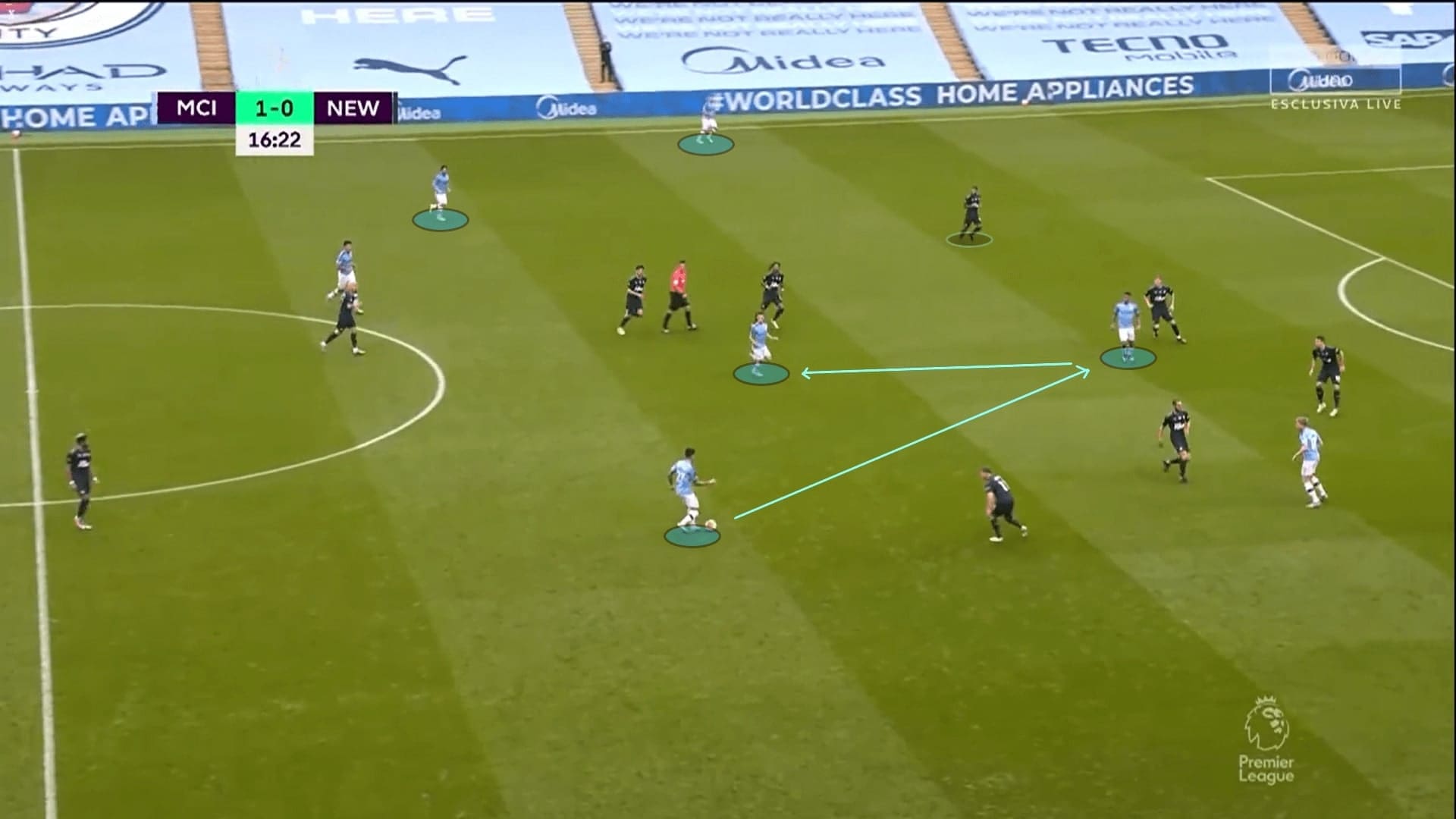
The qualitative superiority was quite clear and commonly applied in City’s attack. Riyad Mahrez, a winger with exceptional skills and even the physical superiorities such as small footsteps, body balance and agility, was isolated intentionally. Pep wanted the Algerian winger to challenge the defender in the 1 v 1 situation, converting the physical superiority into qualitative superiority and create the dynamics.
City were developing the attack on the left on most occasions because of the task of D. Silva, as explained, while the right flank was often the underloaded side with spaces and only Mahrez there. When Newcastle put most of the players on the ball-side, the ball circulation would often direct the ball to the opposite flank through Rodri or Stones.
As a result, Mahrez could be found with the condition below – huge spaces and 1 v 1 isolation on a defender. The Algerian winger could basically do whatever he wants, showing his flair to beat the defender.
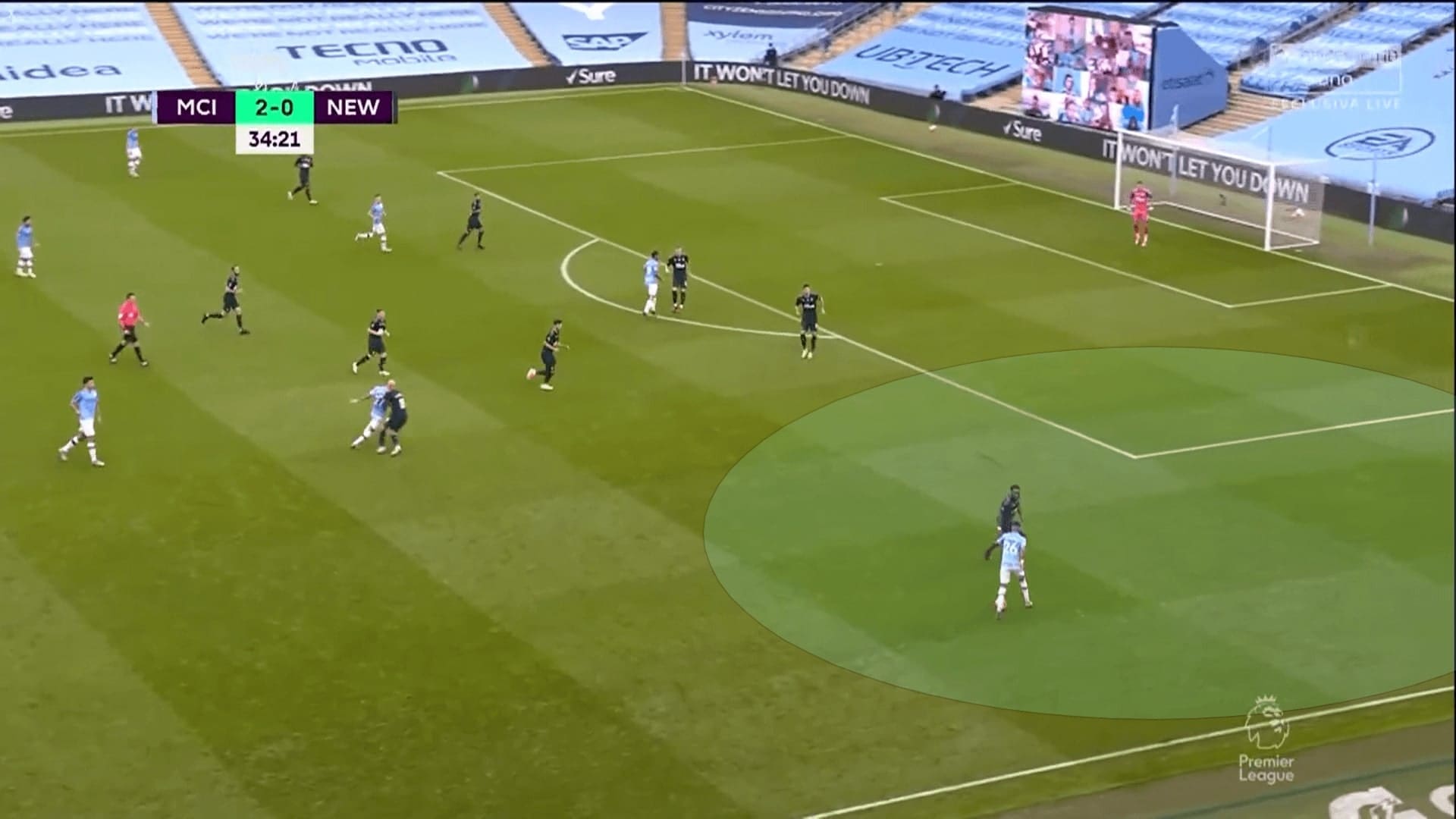
Once again, De Bruyne played deeper and this proved to be a smart move again. We mentioned earlier how the low positioning of the Belgian international could help to control the transitions. From an offensive standpoint, the deep runs were difficult for Newcastle to track. These underlapping runs in the half-spaces is a trademark at Pep’s City.
Because of Mahrez’s qualitative superiority, the oppositions were aware of him. This gave the Algerian winger a chance to utilise the positional superiorities, as seen below, when he stayed between four players and freed himself from the markers.
Also, Kyle Walker’s physical superiority (pace) should never be neglected. Consequently, four pair of eyes were on the duo and no one noticed De Bruyne’s run. This angle allowed us to observe Ritchie (#11) and Federico Fernández’s (#18) perception angle and their blindsides. Without real and intense pressure on the ball, just an easy pass from Walker could release De Bruyne to cross.
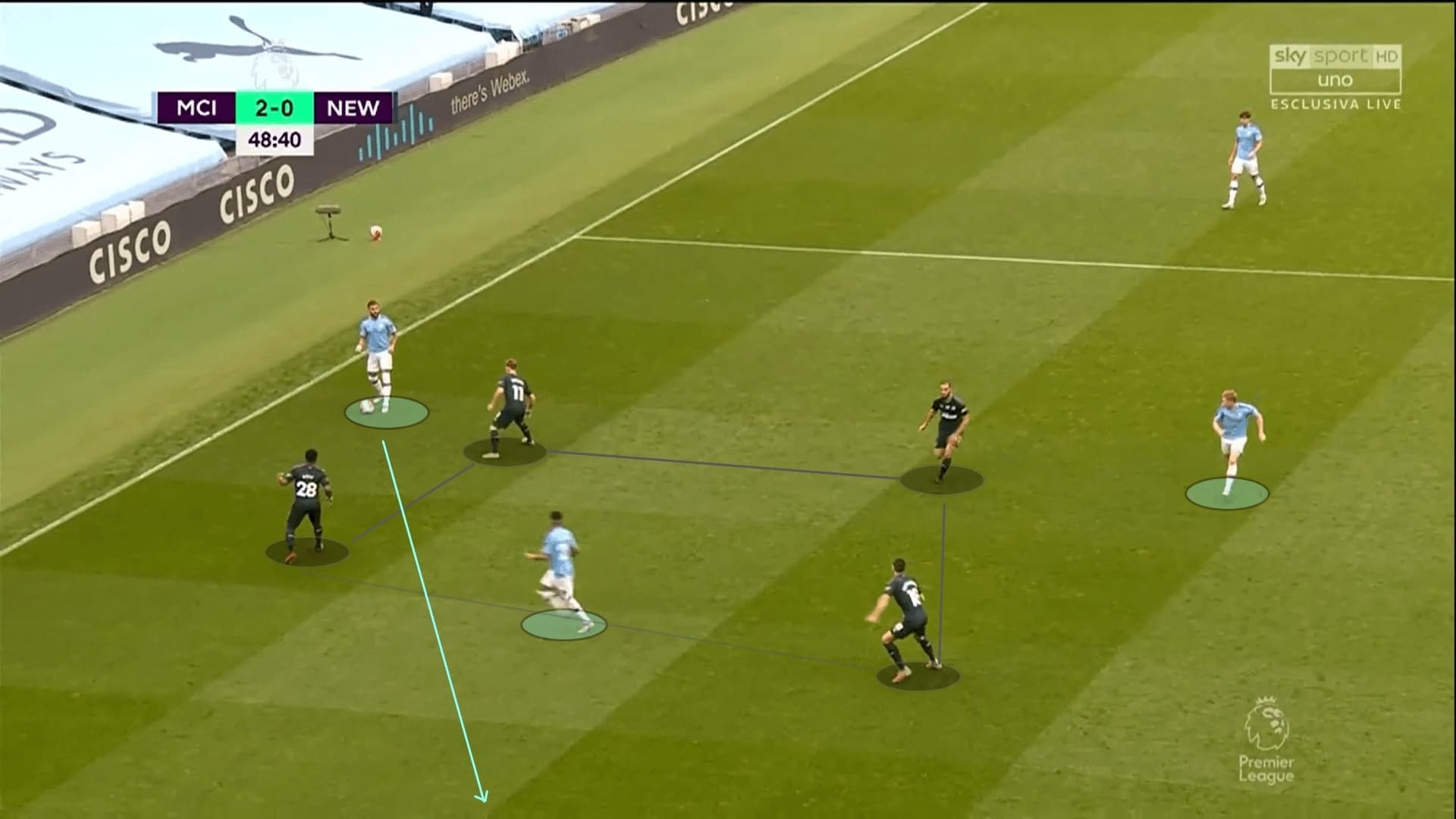
Transition phases
Similar to the last clash, City also dominated the transitions and the threat of Newcastle was limited to 0.21 xG and one shot on target. From Newcastle’s perspective, the performance in duels was not the best and it was a difficult game for Joelinton. We thought Joelinton could serve as a target man, hold-up plays and attack spaces behind the defence. None of that was shown in this game.
Below is the duels graph of Bruce’s men. Although Joelinton had more duels than any other of his teammates, the success rate was also the lowest (29% from 24 trials). Also, notice the vacuum central circle below, the Magpies were not forcing enough duels in this key area to trigger the counter-attacks. Without a strong physical presence as a starting point, hardly could the away team exploits the exposed City defence in the transitions.
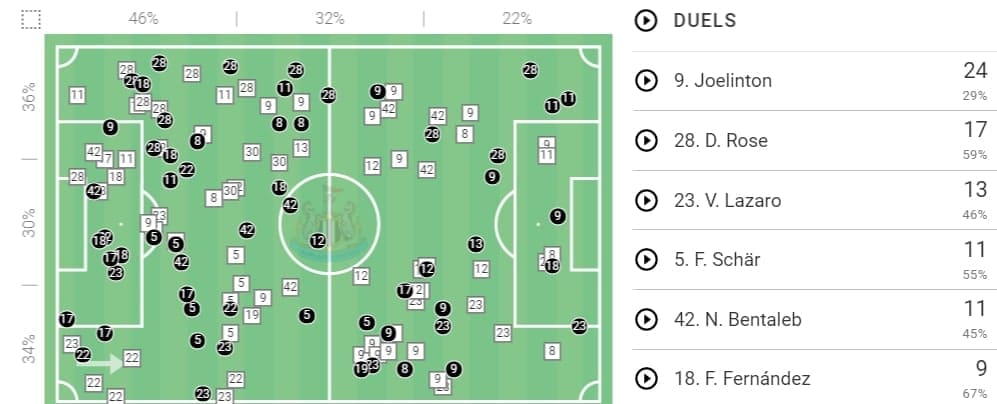
Without Saint-Maximin and Almirón, perhaps Shelvey was the only man Newcastle could count on. The former Liverpool midfielder has been an exceptional long-range passer, possessing the ability to deliver the pass to a free player in space accurately.
As an example, when all City players were counter-pressing on the ball-side, Shelvey recognised the timing to switch the ball to the weak-side and released a free player to progress the attack.
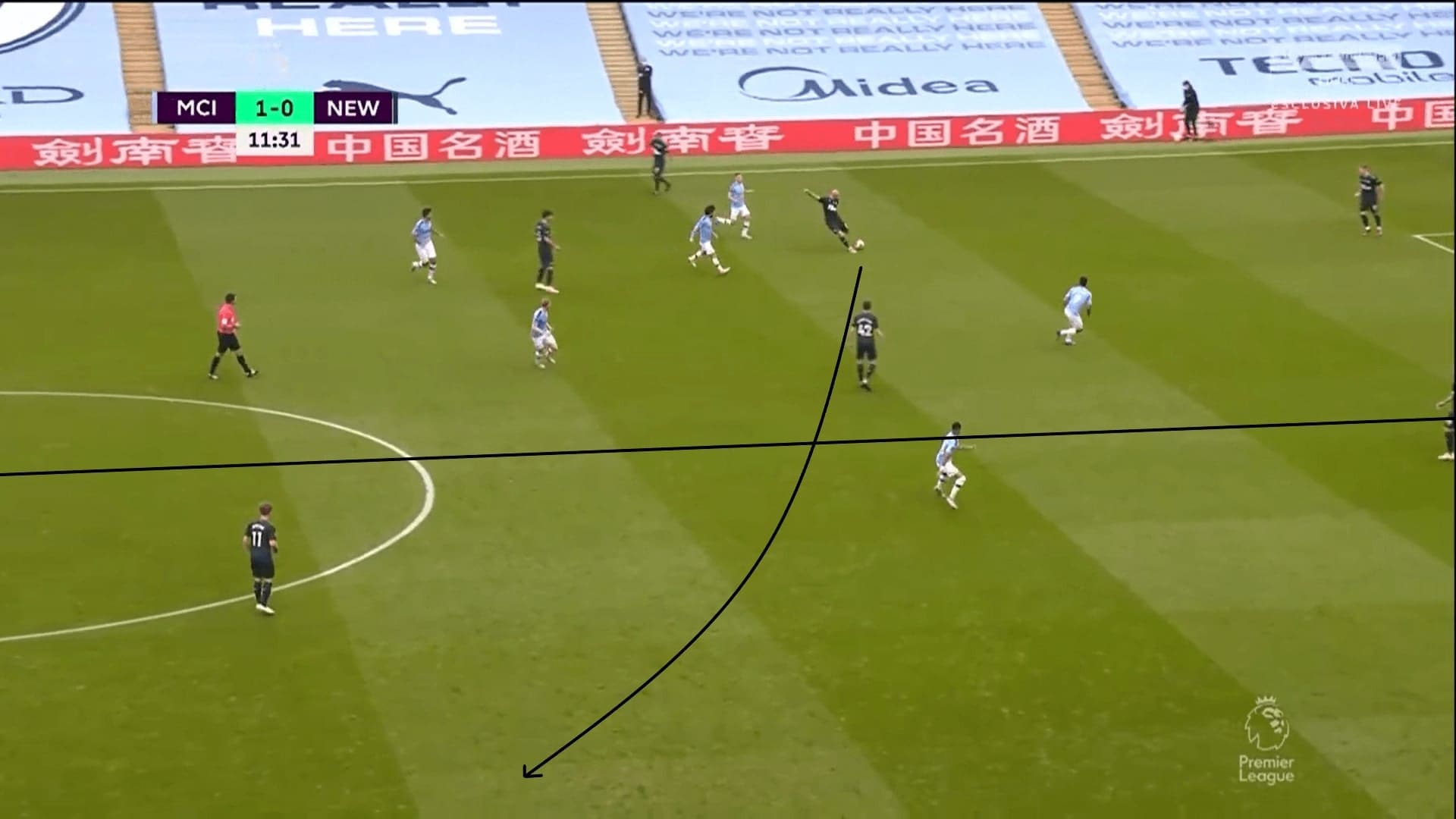
Therefore, Shelvey was the hope, but he was not prioritised as a receiver in the setup today. His partner, Schär could not replicate the same services. When the ball fell to other players, the compactness of the defence constrained the positionings of players. The Magpies were trying to play in tight spaces and hardly could this progress because of the counter-pressure.
Here, Newcastle regained possession but the close proximity of players was an issue. The players in the lineup lacked the flair to pick the free option quickly and under pressure. Shelvey and Lazaro were free here, but they were not noticed and the counter-attack opportunity was gone.
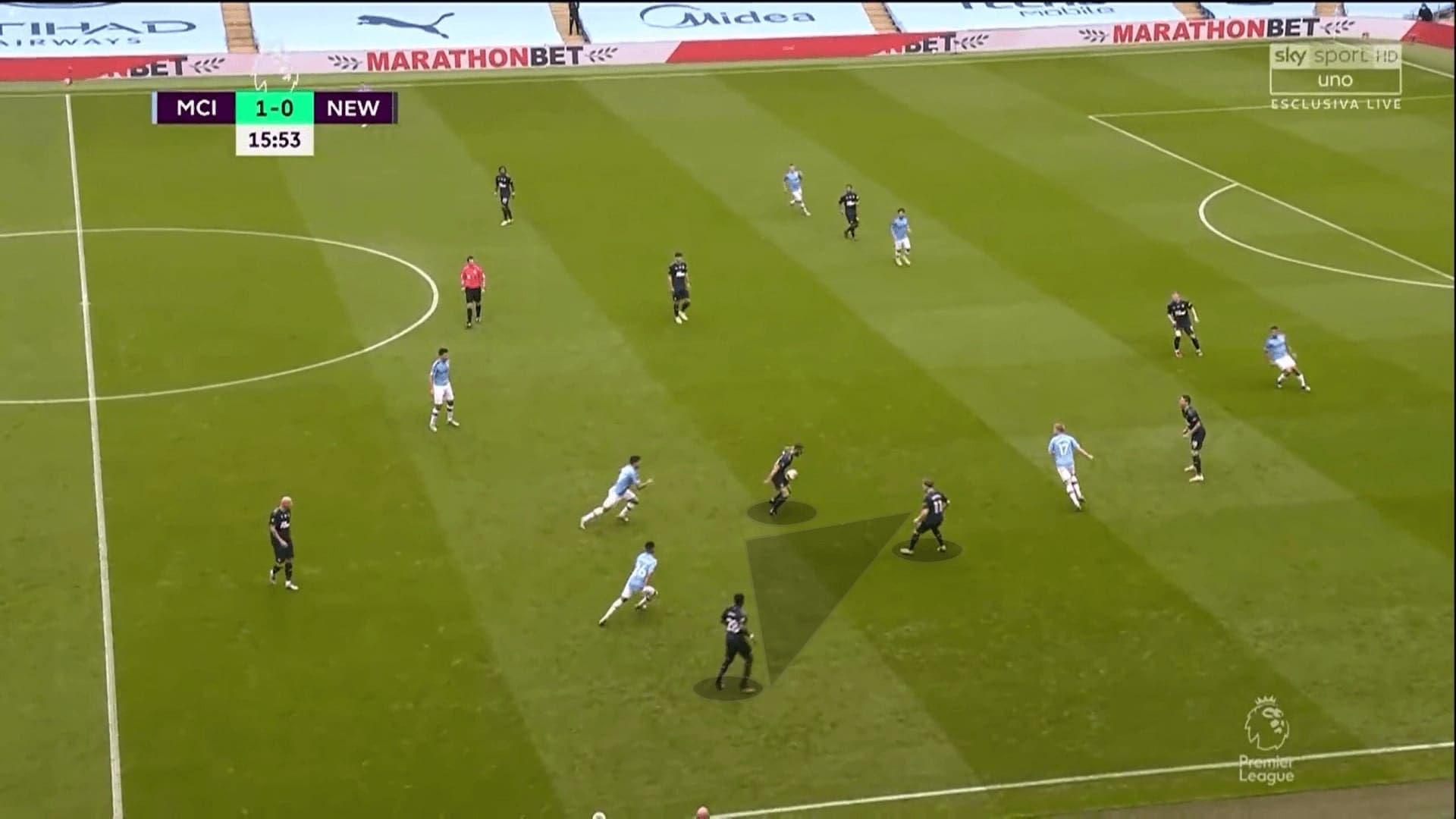
Even when there was some room to progress and City could not counter-press instantaneously, things were still difficult because of the underload against the rest defence. Otamendi and Stones always enjoyed a 2 v 1 numerical advantage on the striker. Neither Joelinton nor Dwight Gayle possessed the pace to beat the defenders and reach spaces behind them too.
Because of the deep block as the game has progressed, Newcastle regained possession in the own third and there was a long way to reach Ederson. Without strong ball-carriers such as Saint-Maximin, no players could bring the ball forward and initiate a counter-attack. Lazaro was okay in the first 15 minutes, but the impact diminished very soon.
As a reference, Newcastle tried to capitalise on the offensive transition below but hardly could this continue. Gayle was contained by the centre-backs while Gündoğan did well to delay.
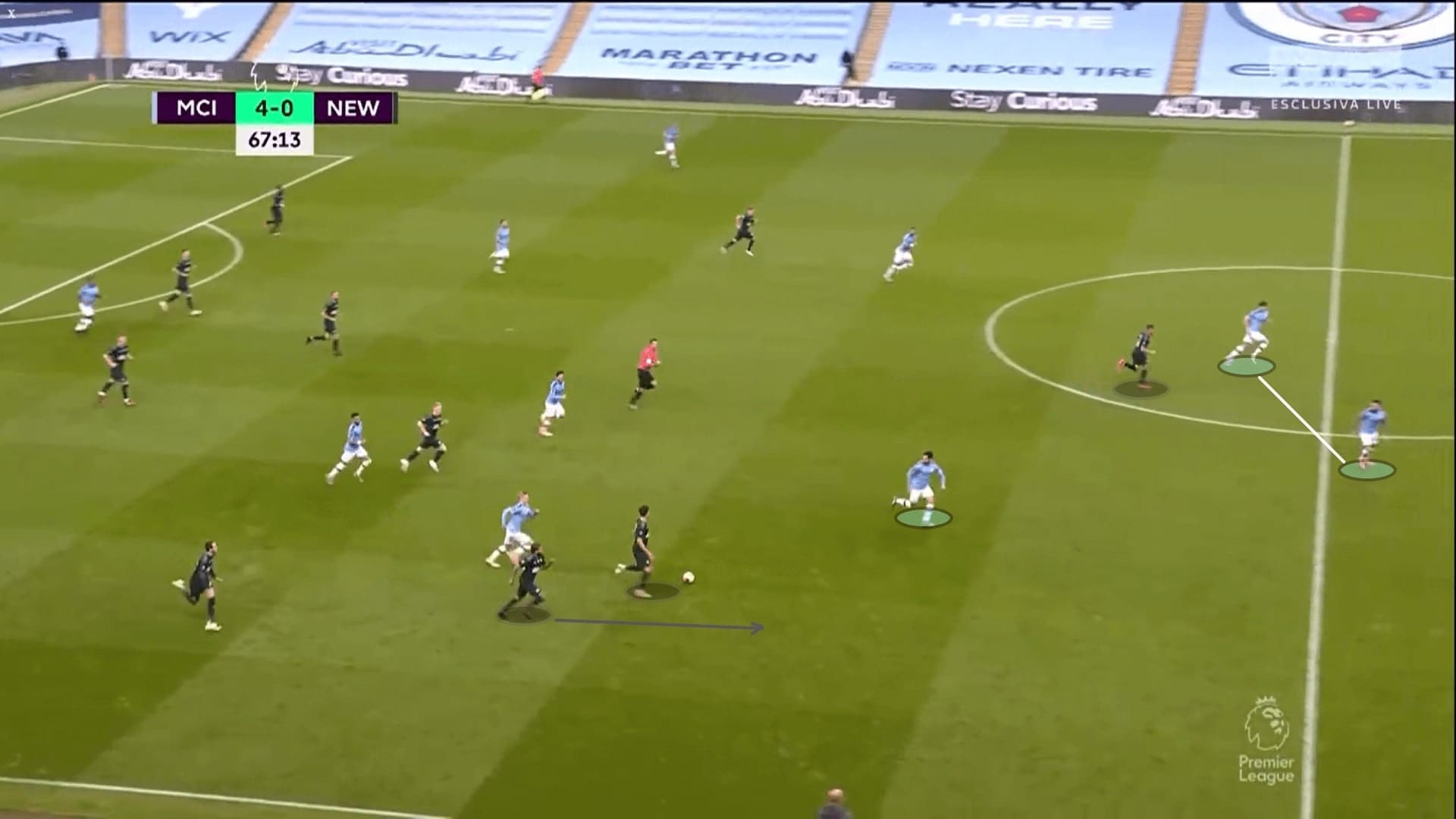
And lastly, we are showing you the excellent counter-press of City that suffocated most counter-attacks. The moment you lost the ball, you are defending. Therefore, the attacking positionings directly affected the possibility and quality of the counter-presses. The Citizens were dominating both phases well, including the transitions because of the offensive setups.
Here, notice the close proximity of players and especially Zinchenko. Occupying the outer zone was not dogmatically executed, the Ukrainian understood the context and stayed close to Rodri when needed. As a result, City were counter-pressing the opponents in extremely tight spaces, and most opponents did not have the skill and composure to escape it.
As we have drawn the arrows, the well-balanced positionings of players could potentially pressure multiple opponents. The best was Foden, who could double-press with D. Silva, chase the return pass or engage the wide player. Even if D. Silva could not win the ball in the initial attempt, the collective defensive actions and pressure could continue.
Also, look at the diverse directions of the arrows, City were executing this counter-press with many angles. Combining with the intensity and aggressiveness of the pressure, it was almost impossible for Newcastle to counter-attack.
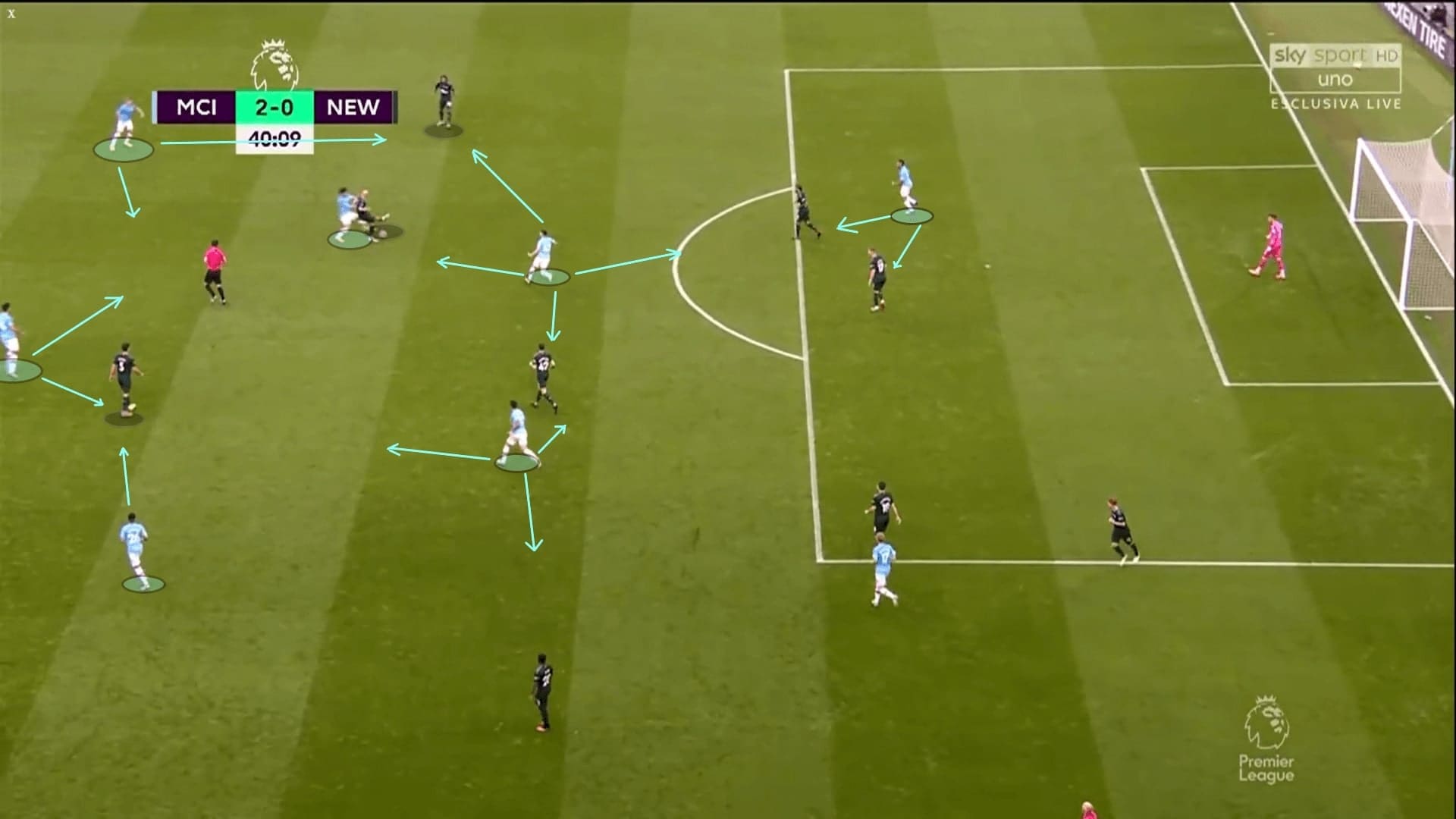
Final remarks
Although it seems like another routine victory, the way that Pep’s players were demonstrating the basics of football were exceptional. The way they attacked with the positional plays and the off-the-ball behaviours of players should be mimicked by many build-up teams. The result showed us that the standard of City was very high and Newcastle had no chance so the Citiznes fully-deserved the win.




Comments